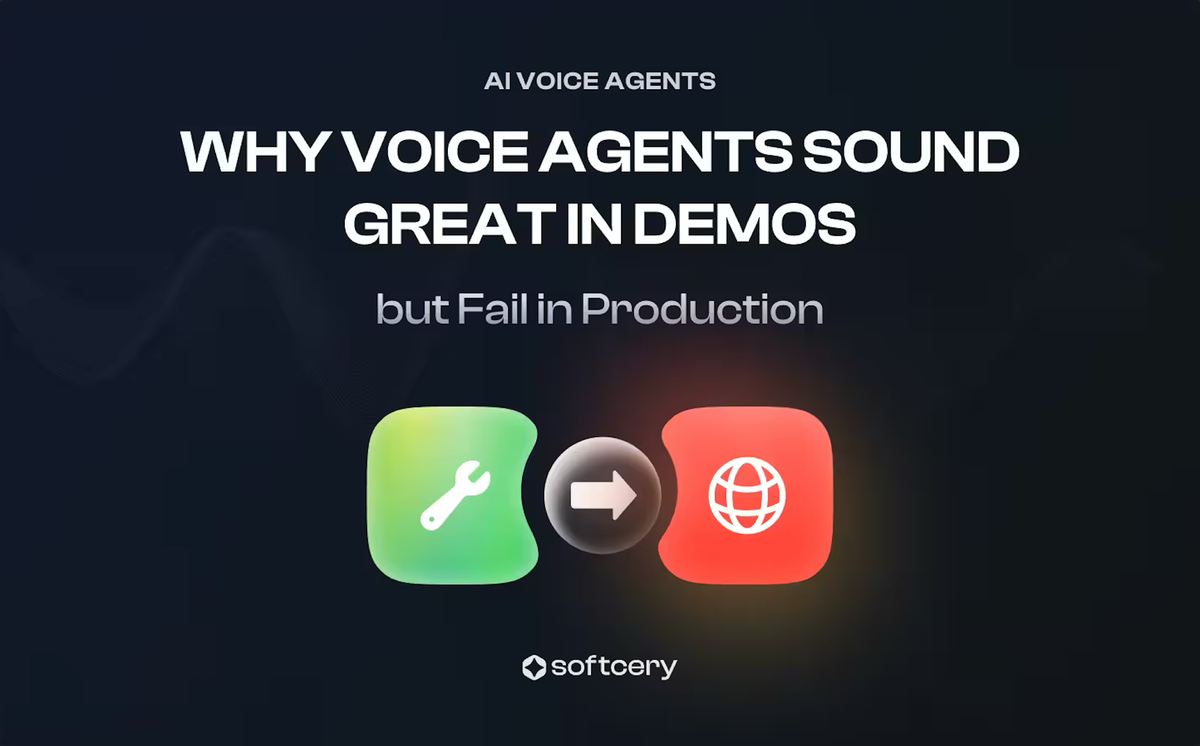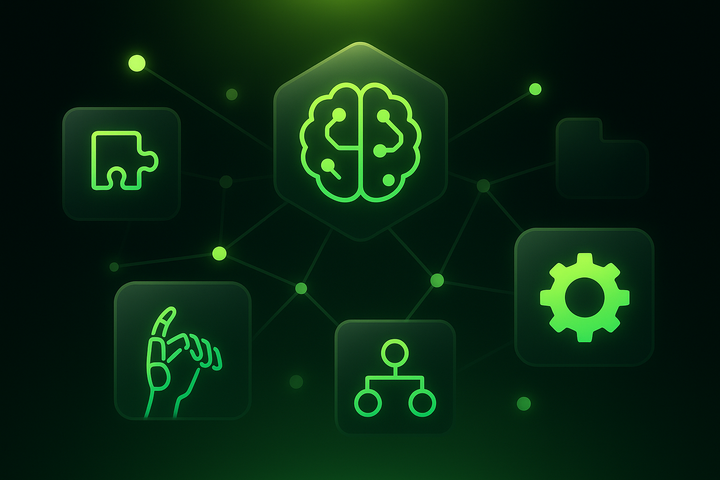
Why Voice Agents Sound Great in Demos but Fail in Production
Think your AI voice agent is ready for production? Discover the technical and business challenges companies face and check tips from Softcery to ensure your voice assistant delivers results in real life.
The impact of AI-based conversational solutions on modern businesses is loud and clear: about 90% of companies reported faster complaint resolution, and more than 80% reported an increase in call handling volume.
But the full picture isn't always shared. In production, voice agents often don’t perform as smoothly as in demos. In fact, real-world agents misfire at a rate closer to 20%, a risk that many companies only discover after rollout.
Still, you can avoid falling into the demo trap and bring a truly valuable voice assistant to your business. Softcery created this article to highlight the most common challenges businesses encounter when moving from demos to production, and to share practical tips backed by our project experience.
The Demo Effect: Why Conversational AI Voice Agents Impress in Controlled Environments
How is it possible that businesses receive the promised product but not the promised results? It's simple: the working conditions of voice agents are different.
For a better understanding, just recall what demos look like:
- Controlled scenarios: Typically, you will see a single, perfectly worked-out example, such as how a voice AI bot can book a flight in a few seconds;
- Perfect environment: A demo version works best when the noise is absent, with completely predictable user behavior and understandable speech.
- Optimised infrastructure: Servers work on a single call; everything is connected in a “laboratory environment” without complex integrations, and tests are conducted on data with clear speech and a standard accent.
Why AI Voice Agent Deployment Breaks Down
Understanding why AI voice agents break down is the first step to building a solution that actually works in real life. So let us guide you through the most common failure cases and show what they can teach businesses.
Looking to avoid common pitfalls and launch a voice agent that delivers?
Technical Reasons
First, let's talk about technical reasons that can trip up voice agents in real-world conditions.
Conversation Design Limitations and NLU Gaps
In the real world, unlike in demos, people don't follow scripts. They change their minds or ask questions that the system wasn't trained to handle. Add some background noise, strong accents with slang, and see the results: the voice agent is completely lost, and the customer experience quickly shifts to outright irritation.
McDonald's AI drive-thru pilot is an outstanding example: the system produced too many errors under noisy, unpredictable conditions, which forced the company to shut down the program.
Integration Challenges
In a demo, the voice agent looks flawless because it's isolated. At this stage, a voice agent doesn't need to fetch data from your CRM or query records from a legacy database.
But in production, these integrations are non-negotiable. A real customer expects the agent to know their purchase history or process a refund, and that requires deep integration with systems that might not be built for AI.
Production Traffic
Demo rarely works with the load companies' experience. Usually, they showcase one call, and the system seems lightning-fast. But the moment you go live, you might face hundreds of calls per minute. If the development team doesn't design the architecture for auto-scaling, you will end up with delayed responses and dropped calls.
Need an AI voice solution that handles real workloads?
Security Vulnerabilities
Data security is a priority for every business; at the same time, it is also the most sensitive element.
In 2017, the BBC demonstrated how to hack HSBC's Voice ID, and in 2023, Vice journalists passed voice authentication at banks using AI-generated clones of their own voices.
Risks are even higher when companies rely on platform-hosted voice AI agents. Businesses don’t usually have access to data processing and storage, meaning systems can keep unencrypted audio or embeddings longer than expected, and access management isn’t under the company's direct control.
Poor Data Lifecycle Management
Data lifecycle planning may seem like a detail, but ignoring it often results in the loss of important data. HM Revenue & Customs (HMRC) has poorly thought-out data collection and management logic. After a short time launching their voice recognition system, the Information Commissioner's Office forced HMRC to delete the voice recordings of approximately 5 million users because the authority had not obtained “explicit consent” from clients to collect biometric data.
Business Reasons
But don't pin all the blame on the tech side. Many AI voice agent projects stall because of business decisions that can block the whole integration from succeeding.
Over-Automation
Rushing to automate every possible process is a recipe for a crash. Take the Social Security Administration (SSA) case as a cautionary tale about how over-automation, a lack of an "escape hatch" to human support, and minimal pilot testing can backfire.
SSA rolled out an AI-powered anti-fraud tool on its National 1-800 Number to flag potentially fraudulent claims. Sounds smart, but in practice, the AI flagged just two claims out of over 110,000 and managed to slow claim processing by 25%. SSA's new AI voice bot couldn't succeed as well: the voice bot misinterpreted questions, gave inaccurate answers, callers struggled to reach live agents, and some were disconnected before getting their questions answered.
Ignoring Change Management and Training
Even the smartest AI agent won't save the day if your team doesn't know how to work with it. Remember, AI is a relatively new technology, and people are still trying to understand how to use it to the best. Do not expect managers to understand in what cases they can rely on AI voice bots and when they need to step in without proper training. Moreover, 28% of workers are worried that AI might replace their jobs, so the adoption of AI voice agents might be a stress factor for a big part of your employees.
Ready to bring a reliable AI voice assistant to your business?
How to Build an AI Voice Agent That Works: Practical Tips to Avoid Production Pitfalls
Now, when you understand the demo-to-production gap reasons, we can move on to tips based on Softcery's expertise.
1. Automate Gradually
One of the biggest mistakes companies make is trying to build an AI voice agent that can handle all the processes a business team does every day.
Our advice is to move step by step:
- Don't hand over the entire process to AI right away. Focus on one area that is easy to automate and can bring quick wins, for example, handling intake calls.
- Define how you'll measure success. Your KPI might be cutting average time from 2 minutes to 30 seconds or saving 30% on support costs.
- Plan before you build. Outline the core use cases and set clear quality standards.
That's exactly the approach we took when building CaseGen, an AI-powered legal intake and receptionist agent. Since every missed call meant losing a potential client, giving full control to AI wasn't an option. Instead, the Softcery team decided to start by automating after-hours calls, which were previously lost. Starting small proved the right choice, and from there, the CaseGen agent grew into a much more capable assistant.
2. Map Integrations
Before you deploy your agent, take a look at every system it talks to. Integrations are tricky, but a few proactive steps can save your development team hours:
Integrations are tricky, but a few proactive steps can save your development team hours:
- Build a clear system map with APIs, databases, or middleware that the agent will touch.
- Identify high-latency points and batch or cache requests where possible;
- Use async pipelines for back-end calls so the agent can respond quickly, no matter how many requests it is processing in parallel;
- Log every external call with timings and errors; logs will become critical for troubleshooting after deployment.
3. Build Security Step by Step
Attempts to meet every AI voice agent's regulatory standard at the earliest stage are an unnecessary expense and slow down the development. Try to establish a solid baseline of security and access control first, then scale up as business needs grow:
- Encrypt by default: Use automatic AES-256 encryption at rest and protect all data transmission with TLS;
- Tighten access: Combine two-factor authentication with fine-grained IAM to grant only the minimum required privileges;
- Keep track: Enable audit logs to see who accessed production data and when.
Want to implement a voice agent that actually works in real-world conditions?
4. Test on Multiple Levels and Don't Limit Yourself to Manual Calls
You will be surprised how many production issues you can prevent with high-quality testing. At Softcery, we've learned that the best safeguard is a multi-level testing approach:
At Softcery, we've learned that the best safeguard is a multi-level testing approach:
- Text-based evaluation tests: Before you add the complexity of voice, make sure you have validated your agent's core logic in text mode (LLM responses, conversation flows, and edge cases). This step will help your team eliminate trivial errors during manual testing. Helpful tools: OpenAI Evals, DeepEval, LM Evaluation Harness, LangSmith.
- QA in real conditions: Move to test with real voices, background noise, and accents. At this stage, developers should listen to recordings, review transcripts, and provide feedback.
- AI-vs-AI simulations: Use other AI voice agents with pre-defined personas and scripts to communicate with your agent. This helps reveal weaknesses in conversation flow, interruption handling, and latency. Bonus: a multimodal LLM can analyze results automatically so only negative cases go to developers.
- Load testing: Finally, simulate scale. Start with a few parallel calls, then use specialized tools like Cekura or Hamming.ai which can generate hundreds of calls simultaneously and deliver detailed performance reports.
5. Keep It Simple
Whether your users are experts or not, simplicity drives adoption. In the early stages of the Softcery-CaseGen collaboration, our team first thought about fine-tuning a model. The challenge was that the agent would sometimes fail to follow instructions.
Fine-tuning looked like a possible solution, but training separate models for slightly different attorney scenarios wasn't practical in terms of time and cost. So we found a better option: prompt engineering and clear conversation flows - and it worked.
Conclusion
Avoiding the demo trap is easy once you recognise the common challenges of implementing voice agents and have a clear plan throughout the development process.
At Softcery, we've developed a strategy for building AI voice assistants that succeed in production and shared these insights with you: planning, thoughtful integrations, multi-level testing, gradual security measures, and prompt engineering are key to building a reliable voice agent for your business.
Don’t let your voice AI fail in production.



Comments